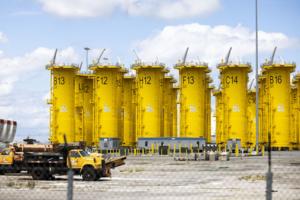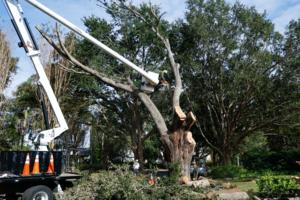Science & Technology
/Knowledge

Pine beetles are poised to decimate Colorado Front Range forests: 'Our ability to stop the spread is very limited'
DENVER -- Vast swaths of the ponderosa pine forests that blanket Colorado’s Front Range mountains could turn rust-colored and die over the next five years as pine beetles begin to spread aggressively, new federal forecasts show.
Aerial surveys conducted by the U.S. Forest Service over the last year found evidence of rapidly spreading beetle ...Read more

New England unions push back against Trump administration's move to freeze offshore wind projects
BOSTON — Worker unions and politicians in New England are pushing back against the Trump administration’s move to implement a 90-day freeze on five industrial-sized offshore wind projects off the East Coast, including the Vineyard Wind 1 windfarm off of Nantucket.
Ironworkers Local 7, which represents over 3,600 workers across New England, ...Read more

Dominion files suit against Trump administration, says halting wind project is 'arbitrary and illegal'
Dominion Energy is suing the Trump administration following its decision Monday to suspend the federal lease for the wind-power project off the coast of Virginia Beach just months before it was slated to start producing energy after more than 10 years of work.
The Interior Department paused the leases for five offshore wind projects, citing ...Read more

Toys are talking back thanks to AI, but are they safe around kids?
Stuffed animals that talk back. Chessboards with pieces that move on their own. And a chatty holographic fairy in a crystal ball.
Your next toy purchase might be powered by artificial intelligence and able to converse with your kids.
Chatbots and AI-powered assistants that can quickly answer questions and generate texts have become more common...Read more

California crypto company accused of illegally inflating Katy Perry NFTs and fraud
Four years ago, California startup Theta Labs' cryptocurrency was soaring, and its future appeared bright when it landed a partnership with pop star Katy Perry.
The Bay Area company had built a marketplace for digital collectibles known as nonfungible tokens, or NFTs, and had teamed up with Perry to launch NFTs tied to her Las Vegas concert ...Read more
Suspected shark attack at California occurred in time and place where large sharks come to feed
It’s peak bulking-up season for white sharks in Monterey Bay, and over the past week, two animals previously tagged by scientists passed through the waters near Lovers Point — the same area where swimmer Erica Fox vanished Sunday, after witnesses reported seeing a shark nearby, experts said.
Fox, the 55-year-old co-founder of recreational ...Read more

C.H. Robinson, a logistics stalwart, disrupting industry with AI
C.H. Robinson, one of the world’s largest logistics providers, has gone from disrupted to disruptor.
Five to 10 years ago, the Eden Prairie-based company was facing an existential threat from digital startups in the logistics space.
Firms like Uber Freight and Conroy Logistics believed they could digitize the processes of connecting shippers...Read more
Maryland climate commission calls for state action amid budget pressure
The Maryland Commission on Climate Change released its 2025 annual report Tuesday, offering a new set of recommendations aimed at helping the state meet aggressive greenhouse gas reduction goals while preparing communities for the growing impacts of climate change.
In the 22-page report, the commission outlined both advances and challenges as ...Read more

Tech review: Anker dock makes quick work of connecting your peripherals
My first computer was a Macintosh Plus, which was an all-in-one computer with a built-in black and white monitor.
Then I moved up to an actual desktop PC, with a separate color monitor.
Back then, laptops were expensive and not very small, and they used slower components and were not very expandable.
In the last decade, laptops pulled even ...Read more

California's plastic bag phaseout nears, but leftover bags remain unregulated
At the Target store on Riverside Boulevard on Friday, stacks of plastic bags sat prominently at checkout counters — the only visible option available for shoppers at both self-checkout kiosks and traditional lanes.
Under Senate Bill 1053 that passed in 2024, those plastic bags are set to disappear from checkout counters by the end of 2025.
...Read more

Why California's milk cartons may lose their coveted recycling symbol
LOS ANGELES — California milk cartons may lose their coveted recycling symbol, the one with the chasing arrows, potentially threatening the existence of the ubiquitous beverage containers.
In a letter Dec. 15, Waste Management, one of the nation’s largest waste companies, told the state the company would no longer sort cartons out of the ...Read more

SpaceX defends airspace safety ahead of Florida Starship launch plans
ORLANDO, Fla. — With plans to launch the massive Starship from Florida next year, SpaceX defended its commitment to airspace safety after a Wall Street Journal article claimed an explosive mission in early 2025 was a greater danger to some flights than previously reported.
The article published Saturday cited Federal Aviation Administration ...Read more

Editorial: Climate change Grinches look to ruin the holidays
Who doesn’t have a soft spot for the smells of the holidays? The aromatic cinnamon stick flavoring a cup of eggnog or the hint of vanilla in grandma’s baked goods can trigger wonderful memories of the Christmas season.
Leave it to progressive climate Grinches to warn that global warming represents a threat to some of these cherished ...Read more

How Agility Robotics uses artificial intelligence, from their humanoid 'Digit' to everyday workflow
Digit the humanoid robot is 5 feet 9 inches tall and lives in warehouses, helping its human coworkers move and stack boxes up to 35 pounds. It also "smiles" and waves.
Robots like Digit are a growing pursuit among robotics companies that are trying to bring humanoids into everyday life, and specifically into the home as helpers. A crucial part ...Read more

It's been 25 years since America decided to save the Everglades. Where do we stand?
The 20th century was horrible for the Everglades. The broad shallow river, one of the most unique ecosystems on the planet, was labeled wasteland and ruthlessly dammed, carved into parcels, dried out and diverted into near oblivion.
But at the end of the century, 25 years ago this month, Democrats and Republicans from Florida and Washington, D....Read more

Orlando officials say tree count is good investment, despite DOGE criticisms
ORLANDO, Fla. — Florida Chief Financial Officer Blaise Ingoglia blasted several line items in Orlando’s budget as “wasteful” spending, but by far the largest was $450,000 to count its trees.
“Maybe they’re trying to find the money tree? Oh, they already found it – it’s you the taxpayers,” Ingoglia said in October, a criticism ...Read more

Vince Zampella, 'Call of Duty' co-creator, dies after crash on Angeles Crest Highway
Vince Zampella, the video game developer who helped launch the wildly lucrative and enduring "Call of Duty" franchise and "Apex Legends" studio Respawn Entertainment, has died.
A representative for Electronic Arts, which owns Respawn, confirmed Zampella's death Monday in a statement shared with The Times. He was 55.
"This is an unimaginable ...Read more

Fight between Waymo and Santa Monica goes to court
Waymo is taking the city of Santa Monica to court after the city ordered the company to cease charging its autonomous vehicles at two facilities overnight, claiming the lights and beeping at the lots were a nuisance to residents.
The two charging stations at the intersection of Euclid Street and Broadway have been a sour point for neighbors ...Read more

Instacart ends AI pricing test that charged shoppers different prices for the same items
Instacart will stop using artificial intelligence to experiment with product pricing after a report showed that customers on the platform were paying different prices for the same items.
The report, published this month by Consumer Reports and Groundwork Collaborative, found that Instacart sometimes offered as many as five different prices for ...Read more

Kentucky Senate Republicans blast environmental report calling for end to state's coal dominance
LEXINGTON, Ky. — Recent temperature swings in the Bluegrass State underscore why Kentucky lawmakers are still clinging to coal, according to Senate Republicans who responded to new research by environmental groups calling for an end to the state’s alleged overreliance on fossil fuels.
Mid-December’s subfreezing temperatures proved why ...Read more
Popular Stories
- Toys are talking back thanks to AI, but are they safe around kids?
- Dominion files suit against Trump administration, says halting wind project is 'arbitrary and illegal'
- Pine beetles are poised to decimate Colorado Front Range forests: 'Our ability to stop the spread is very limited'
- Suspected shark attack at California occurred in time and place where large sharks come to feed
- California crypto company accused of illegally inflating Katy Perry NFTs and fraud





